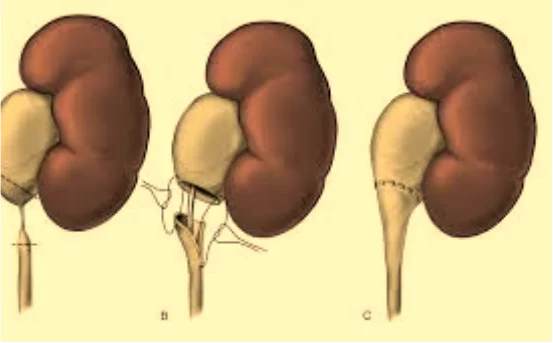Pyeloplasty surgery is a surgical intervention done to fix the blockage of urine flow at the ureteropelvic junction (UPJ), resulting in urine stagnation due to the obstructed passage between the kidney and urine bladder. This condition affects a large number of people, and if not addressed, it poses a risk of serious complications like hydronephrosis, recurrent pyelonephritis, or renal insufficiency. Early identification of the signs which suggest the need for pyeloplasty greatly enhances the possibility of successful intervention.
What Is The Pyeloplasty Surgery?
A pyeloplasty surgery involves excising the blocked segment of the ureter and reconnecting the remaining sections for the seamless passage of urine from kidney to bladder. Currently, most pyeloplasties are performed using laparoscopic or robot-assisted minimal access approaches.
It is done most often when the UPJ obstruction accesses symptomatic or starts impairing the kidney function.
Prominent Symptoms Suggesting Toward Pyeloplasty Surgery
Understanding the symptoms for pyeloplasty surgery
Due to the quiet nature of UPJ obstruction, patients might not notice it for a long while until they have an ultrasound. Below are the warning signs that suggest the patient is progressing towards need of a pyeloplasty surgery:
Flank pain or abdominal pain
These are the earliest features that people notice.
- The discomfort can be throbbing, striking, or pressing and it can occur predictably or sporadically.
- Usually felt on one side, depending on which kidney is involved.
- Often worsens after drinking fluids.
Recurrent Urinary Tract Infections (UTIs)
- Persistent or recurring UTIs may signal stagnant urine due to obstruction.
- Symptoms sinclude fever, burning with urination, and cloudy urine.
Kidney Swelling (Hydronephrosis)
- This condition is diagnosed using imaging tests, such as ultrasounds or CT scans.
- Hydronephrosis is the swelling of a kidney due to the accumulation of urine.
- This condition is frequently encountered due to an obstruction and is often a marker for test surgery.
Blood in Urine (Hematuria)
- Blood may be present ‘microscopically’ or visibly in the urine.
- Typically accompanied by pain and discomfort.
Nausea and Vomiting
- When urine outflow becomes critically restricted, toxins can accumulate, which may result in gastrointestinal distress.
- These symptoms are most evident during acute episodes.
Poor Growth in Children
- In children, UPJ obstruction may result in failure to thrive, lack of appropriate weight gain, or growth stunting.
High Blood Pressure
- Elevated pressure is a negligence symptom of UPJ obstruction.
Decreased Kidney Function
- Diminished function of the affected kidney, gradually over time, can be detected with renal scans or blood analyses.
Causes of Ureteropelvic Junction Obstruction
It is important to know the underlying reasons for obstruction as it determines the urgency of surgery and intervention needed. UPJ obstruction may be:
- Congenital: Deficiency in the formation of the ureter or kidney leads to its being present since birth.
- Acquired: Kidney stones, scar tissue from previous surgeries, renal infections, or tumors can all cause an acquired type of UPJ obstruction.
- Functional: Abnormal nerve or muscle activity leads to such obstruction.
Diagnosis: What Tests Are Conducted to Identify the Need for Pyeloplasty?
To confirm if pyeloplasty is needed, doctors conduct several diagnostic tests:
Ultrasound
Reveals the size of the kidney and any signs of hydronephrosis.
CT Urogram or MRI
Offers a detailed view of the urinary tract and helps detect blockages.
Renal Scintigraphy (MAG3 scan)
Assesses kidney function and drainage to measure obstruction severity.
Voiding Cystourethrogram (VCUG)
- Used to rule out vesicoureteral reflux (urine flowing backward).
- These tests help evaluate the impact on kidney health and the necessity of surgery.
When is Pyeloplasty Surgery Recommended?
UPJ obstructions do not always require immediate surgical response. It is usually recommended:
- In cases where recurrent infections or intense pain is noted.
- Imaging indicates progressive hydronephrosis and renal enlargement.
- Kidney function measurement shows significantly decreased performance.
- More conservative measures like treatment with antibiotics or watchful waiting do not yield results.
Surgery may be postponed in children if renal functions are stable. However, close observation is required.
Pyeloplasty Surgery: Anticipated Outcomes
Preoperative Preparing
- Imaging studies and renal function assessment.
- Physical examination along with prior illnesses and surgical procedures.
Steps of the Operation
- The patient will be put to sleep prior to the start of the surgery.
- For quicker postoperative recovery, some surgeons use less invasive methods.
- During the procedure, some parts of the ureter will be cut and a tube (stent) will be placed to allow urine to pass and maintain flow till healing starts.
After Surgery
- stays in hospital for 1-3 days.
- 2-4 weeks after the operation, most patients are back to normal activities.
- Postoperative scans are done to assess the improvement in the drainage and function of the kidney.
Conclusion
Timely intervention prevents devastating consequences of kidney damage. Early recognition of symptoms indicating the need for pyeloplasty surgery significantly alters outcomes. Flank pain, recurrent infections, hematuria (blood in the urine), and kidney swelling are symptoms that suggest serious underlying issues.
If you are noticing these signs, or if someone close to you does, make sure they see a urologist as soon as possible so that they can be completely assessed. Kidney preserving and function-sparing surgeries such as pyeloplasty can be safely performed when patients are diagnosed in a timely manner.























